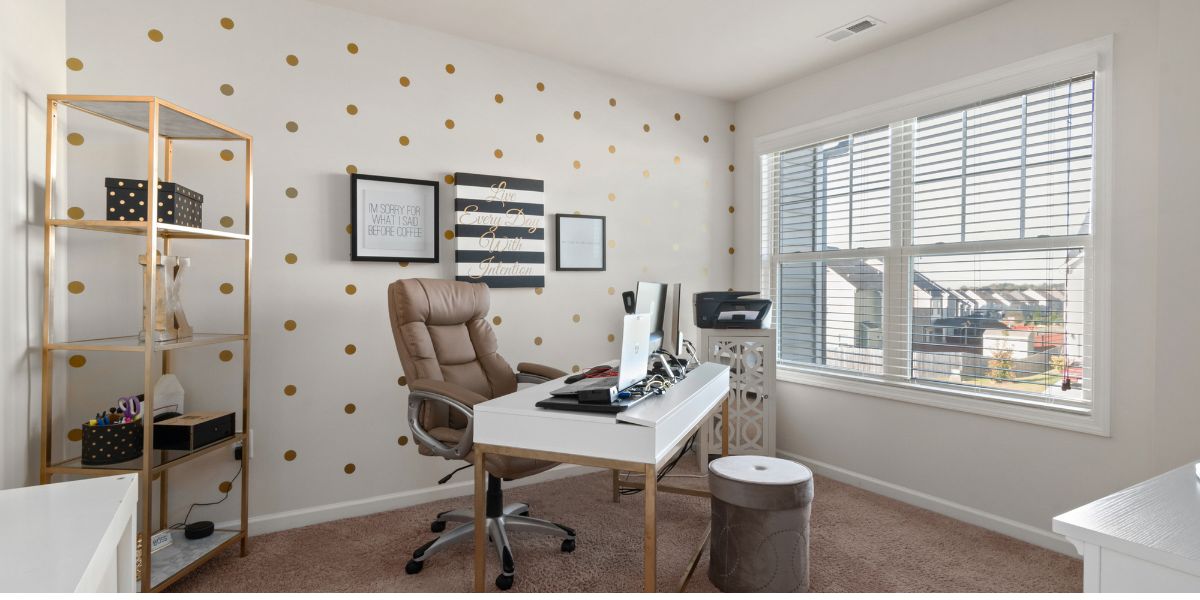The rise of remote work has transformed the traditional office landscape, offering employees newfound flexibility and freedom. As technology continues to advance, more and more individuals are embracing the opportunity to work from home (WFH). While this shift brings undeniable benefits such as increased autonomy and reduced commuting time, it also presents its fair share of challenges, especially for those new to the WFH setup.
For many newcomers in the virtual workforce, establishing an efficient home office that promotes productivity can be a daunting task. The boundaries between personal life and professional responsibilities can blur within the comforts of one’s own abode. Distractions abound, whether it’s the allure of household chores or simply feeling disconnected from colleagues. Additionally, ergonomic concerns may arise without access to proper office equipment or guidance on creating a comfortable workspace. As productive as working in sweatpants may sound initially, navigating these hurdles becomes essential for maintaining motivation and ensuring long-term success while working remotely.
But fear not! In this article, we will provide you with invaluable tips and practical advice on how to transform your living space into a functional haven tailored specifically for remote work efficiency. Whether you’re just starting out on your journey as a WFH employee or if you’re looking to improve your current setup, stay tuned for expert insights that will empower you with solutions suited for today’s dynamic work environment. Let us guide you through creating an oasis where productivity thrives while preserving harmony between professional commitments and personal well-being.
Assessing your needs:
When transitioning to a work-from-home setup, it’s essential to evaluate your individual job requirements. This goes beyond just finding a comfortable chair and desk. Take some time to consider the specific tasks you’ll be performing and what resources you’ll need to perform them efficiently.
Firstly, assess your space availability. Do you have a dedicated room or area that can serve as your home office? If not, think about how you can carve out a designated workspace within your existing living environment. It could be as simple as setting up a small desk in the corner of a room or repurposing an underutilized area for work purposes.
Next, consider equipment needs. What tools do you require to carry out your duties effectively? A reliable computer or laptop is usually non-negotiable in today’s technological age. Additionally, depending on the nature of your job, you may need additional peripherals such as dual monitors for multitasking or specialized devices like graphic tablets for design work.
Lastly, don’t forget about internet connectivity when assessing your needs. Ensure that your home internet connection is fast and stable enough to support the demands of remote work – from video conferences and file sharing to accessing cloud-based platforms and collaborating with colleagues online.
By considering these factors – space availability, equipment needs, and internet connection – you can better understand what adjustments are necessary in order to set up an efficient and productive home office tailored specifically to meet the demands of YOUR job requirements.
Choosing the Right Location
When it comes to setting up an effective home office, one of the most crucial decisions you’ll make is choosing the right location. This goes beyond simply finding a spot where you can plop down your laptop and get to work. It’s about creating a dedicated workspace that is separate from your living areas and helps you establish boundaries between work and personal life.
Having a designated area for work not only enhances productivity but also supports mental well-being. When you physically step into your home office space, even if it’s just a corner in your bedroom or living room, you create a psychological shift that helps signal to yourself and others that it’s time to focus on work.
Finding the perfect location within your home requires some careful consideration. If possible, try to set up shop in a spare room or unused area where distractions will be minimized. However, if space is limited, don’t fret – there are still plenty of options available! Consider transforming an underutilized nook or corner into your sanctuary of productivity. Whether it’s by rearranging furniture or using dividers for privacy, getting creative with the available space can go a long way in creating an efficient home office setup.
Remember, everyone’s living situation is unique, so find what works best for you and adapt accordingly. By intentionally carving out a dedicated workspace within your home, you’ll be well on your way towards fostering a conducive environment for remote work success.
Ergonomics: Prioritizing Long-Term Health
When it comes to setting up a home office, one aspect that is often overlooked but holds great importance for long-term health maintenance is ergonomics. A well-designed ergonomic workspace can significantly reduce the strain on your body and help prevent musculoskeletal disorders in the future.
One of the key elements of an ergonomic setup is choosing the right desk chair. Look for a chair that offers good lumbar support, adjustable height settings, and comfortable padding. Consider investing in a chair with armrests to provide additional support for your arms and shoulders during those marathon work sessions.
If sitting for extended periods isn’t your cup of tea, you might want to explore adjustable standing desks as an alternative. These desks allow you to easily switch between sitting and standing positions throughout the day, reducing the risk of postural issues caused by prolonged sitting.
Essential Equipment: Creating an Organized Workspace
In addition to prioritizing ergonomics, another essential factor when setting up a home office is ensuring optimal desk size and organization. Your desk should be large enough to accommodate all your necessary equipment without feeling cluttered or cramped.
Consider how much space you need for your computer or laptop, keyboard, mousepad, monitors if any, documents/files/papers relevant to your daily work tasks both physical/digital format etc.. An organized workspace not only helps improve focus but also makes it easier to locate important documents when needed – avoiding unnecessary stress!
Take some time before starting remote work full-time or even part-time , analyze what tools you use regularly during work hours so they get prime real estate on desktop while less-used gadgets etc could go somewhere else & optinal do things like assign specific drawers/shelves/cabinet/storage options based off frequencies vs occasional/backup storage thus decluttering visible spaces from non-essential items resulting in more positive mental state while working!
Lighting Essentials
Natural vs Artificial Lighting
When it comes to setting up your home office, lighting is a crucial element that can greatly impact productivity and overall well-being. The first aspect to consider is the choice between natural and artificial lighting. Natural light has numerous benefits, including boosting mood and enhancing focus. Position your desk near a window if possible, as this will allow you to take advantage of the free daylight while also providing a refreshing view during breaks.
However, relying solely on natural light may not always be practical or sufficient for optimal illumination throughout the day. That’s where artificial lighting comes into play. Choose warm white LED bulbs with adjustable brightness settings for overhead lights or desk lamps. These types of bulbs closely mimic natural sunlight and offer versatility in terms of adjusting the intensity according to your needs.
Task Lighting Solutions
While ambient lighting sets the overall tone in your workspace, task lighting plays an essential role in preventing eye strain and improving concentration during focused work sessions. Consider investing in a high-quality desk lamp that provides direct illumination onto your work surface without causing glare or shadows. Adjustable arm lamps are particularly useful as they allow you to position the light precisely where needed.
Additionally, if you frequently engage in activities such as reading physical documents or sketching ideas on paper, choose a lamp that offers different color temperature options (such as cool white or warm yellow) so that you can adjust it based on the specific task at hand.
Remember, striking the right balance between natural and artificial lighting ensures optimal comfort and productivity throughout your working hours. Embrace both sources of light to create an inviting atmosphere while minimizing any potential strains on your eyesight.
Setting Up Your Electronic Essentials
Stable Internet Connection: One of the most essential aspects of a productive home office is a stable and reliable internet connection. Without it, you may experience frustrating disruptions in your workflow and communication with colleagues and clients. To ensure a smooth working experience, consider investing in a high-speed internet plan that is capable of handling any online tasks or video conferences you may have. If possible, connect your computer directly to the modem/router using an Ethernet cable for a more secure and consistent connection.
Laptop or Desktop Computer: Choosing the right device for your work-from-home setup can significantly impact your productivity levels. If you primarily deal with email communications and basic document editing, a laptop might suffice due to its portability. However, if you frequently engage in resource-intensive tasks such as graphic design or programming, opt for a desktop computer with ample processing power and storage capacity. Additionally, make sure that whichever option you choose has sufficient RAM (random access memory) to handle multiple applications simultaneously without slowing down.
Peripherals (Keyboard, Mouse Headphones): Although often overlooked compared to the primary computing device itself, having the right peripherals can greatly enhance your comfort and efficiency while working from home. A good quality keyboard helps prevent typing fatigue during long hours of work; consider choosing one that is ergonomically designed to minimize wrist strain. Likewise, invest in an ergonomic mouse that fits comfortably in your hand for precise navigation across documents or web pages.
Lastly (but certainly not least), do not underestimate the importance of comfortable headphones or earbuds for clear audio during virtual meetings or when listening to music while focusing on tasks—you’ll thank yourself later! Remember that these electronic essentials are tools meant to support you throughout your workday; prioritize functionality and user-friendliness when making decisions about which ones best suit your needs.
With these key electronic essentials properly set up from day one at home—stable internet connection, an appropriate device (laptop or desktop), and ergonomic peripherals—you will be well on your way to creating a functional home office that maximizes productivity and comfort.
Setting up a productive workspace
Organizing your desk
Having an organized and clutter-free desk is essential for creating a productive workspace. Start by removing any unnecessary items from your desk and keeping only the essentials within arm’s reach. This will help minimize distractions and create more space for you to work comfortably.
Managing cables
One of the most common issues with desks is the tangled mess of cables that can make it not only unsightly but also difficult to navigate around. To keep your cables in order, consider using cable management solutions such as cable clips, zip ties, or even cable sleeves. These simple tools can help prevent tripping hazards and avoid accidentally disconnecting important devices.
Utilizing storage solutions
To maximize the efficiency of your workspace, incorporate appropriate storage solutions into your desk setup. Opt for drawers or organizers that allow you to store paperwork, stationery, and other supplies neatly out of sight. By having designated spaces for everything you need, you’ll be able to quickly locate items when required without wasting precious time searching through piles of clutter.
By following these tips on organizing your desk, managing cables effectively, and utilizing storage solutions wisely, you’ll be well on your way to setting up a highly functional home office that promotes productivity and helps you stay focused during work hours. Remember: an orderly workspace fosters clear thinking and allows you to concentrate better on tasks at hand.
Establishing a Routine
Creating Boundaries and Avoiding Distractions
Setting boundaries is crucial when working from home to maintain focus and productivity. To create a boundary between your work and personal life, designate a specific area in your home as your dedicated workspace. If possible, choose a separate room or quiet corner where you can minimize distractions. Let others in your household know that when you’re in this space, you are at work and should not be disturbed unless it’s an emergency.
In addition to physical boundaries, it’s important to establish digital ones as well. Turn off notifications for non-work-related apps on your phone or computer during designated work hours to avoid unnecessary interruptions. Social media platforms and email alerts can quickly become attention magnets, pulling us away from our tasks and decreasing overall efficiency.
Tips for Managing Time Effectively
One of the biggest challenges of remote work is managing time effectively without the traditional office structure holding us accountable. To make the most of each day, start by creating a daily schedule or to-do list outlining specific tasks or projects you want to accomplish.
Prioritize your tasks based on their importance and deadlines so that you can tackle them accordingly. Consider using time management techniques like the Pomodoro Technique – breaking up work into intervals with short breaks in between – which helps improve focus and concentration.
Remember that effective time management also means knowing when to say no or delegate tasks if necessary. Understanding your own limits will prevent burnout and ensure you have enough energy for essential responsibilities.
Scheduling Regular Breaks to Avoid Burnout
Working continuously without taking adequate breaks can lead to burnout over time— both mentally and physically exhausting yourself – resulting in decreased productivity levels. Avoid this by incorporating regular breaks into your daily routine.
Taking short 10-15 minute breaks every few hours allows you to recharge both physically and mentally. Mastering relaxation techniques such as stretching exercises, mindfulness and deep breathing can help you unwind during these breaks.
Also, try to step away from your workspace for lunch or take a walk outside to get some fresh air and rejuvenate yourself. Refilling your cup of energy in this way will enable you to return back to work with a renewed focus and drive.
Personal Touches for Work-Life Balance
Creating a personalized and inviting workspace is not only about functionality but also about fostering a sense of work-life balance. Adding personal touches to your home office can help create an environment that reflects your personality and promotes relaxation, creativity, and well-being.
One way to incorporate personal touches in your home office is by bringing in indoor plants. Not only do plants add a splash of greenery to the space, but they also have numerous benefits for productivity and mental health. Studies have shown that having plants in the workplace can reduce stress levels, improve air quality, and boost mood and concentration. Consider adding low-maintenance plants such as pothos or succulents that require minimal care but still add freshness to your workspace.
In addition to plants, artwork can be another great way to personalize your home office while creating a calming environment. Choose pieces of art or photographs that resonate with you personally – it could be serene landscapes, motivational quotes, or even family photos. Surrounding yourself with images that inspire you or bring back positive memories can help create a soothing atmosphere where you feel more at ease during busy workdays.
Remember, when adding personal touches to your home office for work-life balance, it’s essential not to clutter the space excessively. Find a balance between incorporating meaningful elements while maintaining an organized and functional workspace. By making small adjustments like incorporating indoor plants and hanging artwork you love, you’ll transform your home office into an oasis of tranquility where both work productivity and personal well-being flourish simultaneously
Conclusion:
In conclusion, setting up a well-designed and comfortable home office space is crucial for new WFH employees to maximize their productivity and overall well-being. By following the tips outlined in this article, such as choosing the right furniture, optimizing lighting and ergonomics, organizing your workspace effectively, and incorporating elements of nature, you can create an environment that supports your work goals while promoting a healthy work-life balance.
Remember that investing time and effort into creating a functional home office setup is an investment in yourself and your career. With the right setup, you’ll be able to eliminate distractions, stay focused on tasks at hand, enhance your posture and physical health, reduce strain on your eyesight or body muscles through proper positioning of equipment.
Now it’s time for action – take some time today to assess your current workspace. Identify any areas where improvements could be made based on the tips provided in this article. Whether it’s adjusting your chair height for better posture or decluttering your desk for increased focus – make these changes sooner rather than later.
Your dedicated home office space should reflect not only a productive working environment but also one that allows you to feel motivated and comfortable throughout the day. Let’s optimize our work-from-home experience together by transforming our homes into effective workspaces!





